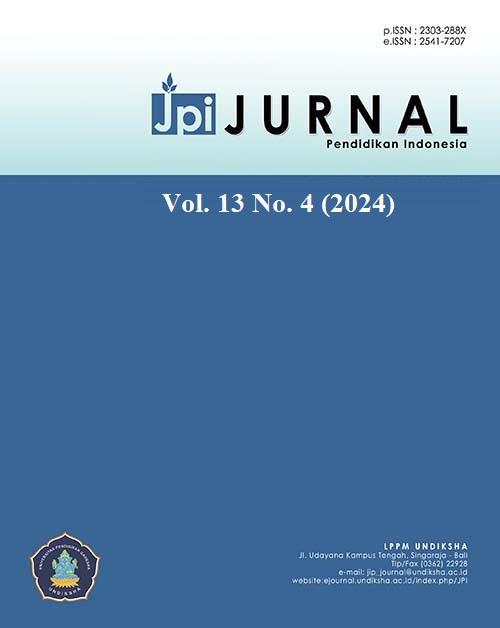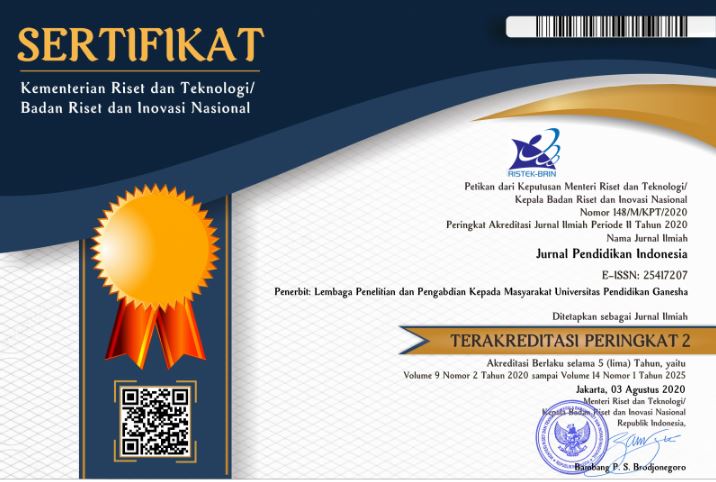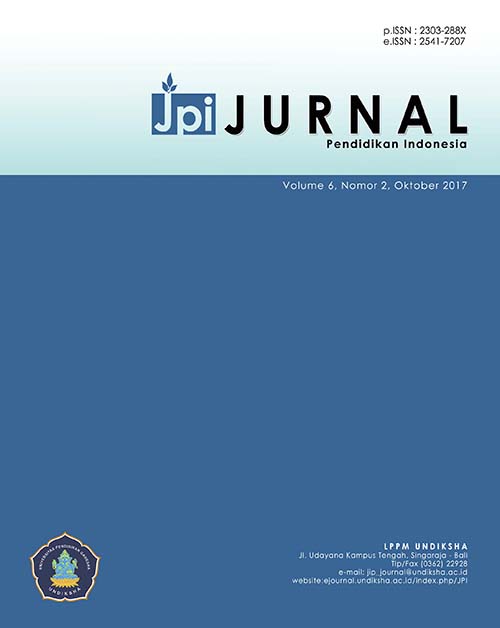iSALTY as a Framework for Combining Three English Language Learning Methods: State-of-the-Art Research
DOI:
https://doi.org/10.23887/jpiundiksha.v13i4.84386Keywords:
Audio Lingual Method, Children, English, Storytelling, Total Physical ResponseAbstract
Early childhood language development is critical, forming the basis for cognitive, social, and emotional growth. Children's brains are particularly receptive to linguistic input during these formative years, which makes them an optimal period for developing language skills, particularly in English. The trend of integrating English language learning in Early Childhood Education (PAUD) has increased rapidly in Indonesia. The main objective of the iSALTY research is to develop and evaluate an innovative learning framework that harmoniously integrates three English language learning methods to increase the effectiveness of the learning process. Using a literature study approach, this research provides a comprehensive review of existing research to advance knowledge in early childhood English teaching. This research used purposive sampling to select 45 references consisting of 12 titles about Audio Lingual Method (ALM), 16 titles about Total Physical Response (TPR), and 17 titles about Storytelling. A structured six-step procedure was followed to ensure a thorough and systematic literature review. This stae of the arts research reveals that integrating ALM, TPR, and Storytelling has the opportunity to form a dynamic and interesting way of teaching and learning. This holistic approach utilizes repetition, contextualization, and physical reinforcement, which effectively enhances children's linguistic abilities in strengthening English language skills. The implications of iSALTY research have the potential to have a significant impact in the context of English language learning at various levels of education.
References
Abbas, N. H., Mustafa., & Zulfitrah. (2020). Pengaruh Penerapan Metode Audiolingual Dalam Meningkatkan Kemampuan Artikulasi Huruf Konsonan Siswa Tunarungu Di SLB Arnadya. Jurnal Inovasi Pedagogi & Teknologi (Jimptek, 2(2), 12–19.
Alexon., K., N., & Pardianson, N. (2019). Applying The Total Physical Response (TPR) Method To Hone EFL Students’ Speaking Skills. JOALL (Journal Of Applied Linguistics And Literature, 7(2), 489–502. https://Doi.Org/10.33369/Joall.V7i2.
Ali, S., Dj, M. Z., & Musfirah. (2020). Imperatiive Sentence To Indonesian Learners Through Total Physical Response (TPR) Method. Didaktika Jurnal Kependidikan, 16(2), 129–144.
Anugerah, R., & Damanik, S. H. (2019). Pengembangan Media Quiet Sebagai Stimulasi Penguasaan Kosakata Bahasa Inggris Anak Usia 5-6 Tahun Dengan Total Physical Response Method Di TK Nasrani 2 Medan. IJOL: Indonesia Journal Of Language And Literature, 1(2), 387–392. https://Doi.Org/Https://Jurnal.Academiacenter.Org/Index.Php/IJOL.
Bojanic, B. R. (2020). Total Physical Response: Theoretical Frameworks And General Principles. PREGLEDNI NAUČNI RAD.
Chamorro, G., & Janke, V. (2019). Educational Bilingualism: Reflections On A Longitudinal Study Of Children’s Cognitive And Linguistic Development (Vol. 10, Issue 1, P. 29). https://Doi.Org/10.1016/J.Amper.2023.100115.
Ghaziabad, D. P. S. (2020). Using Storytelling Method To Help Children Learn More Effectively (P. 36). https://Www.Dpsgs.Org/Ghaziabad/Blog/Using-Storytelling-Method-To-Help-Children-Learn-More-Effectively.
Hanifah, A. S. N. (2020). Implementasi Metode Total Physical Response (TPR) Dalam Pembelajaran Bahasa Inggris Anak Usia Dini Di TK Khalifah Purwokerto. Skripsi Sarjana, Institut Agama Islam Negeri Purwokerto. https://Eprints.Uinsaizu.Ac.Id/8523/2/Cover_Bab I_Bab V_Daftar Pustaka.Pdf.
Hodgins, H., & Harrison, G. L. (2018). Improving Phonological Awareness With Talking Tables In At-Risk Kindergarten Readers. Research In Developmental, 2(Abilities,115(1)), 30. https://Doi.Org/10.1016/J.Ridd.2021.103996.
Indah, C. H. R., Amalyasari, M. R., & Yahmun. (2020). Audiolingual Method To Improve Kindergarten Student’s Speaking Skills At TK Kartika IV 77 Kota Malang. Anfatama: Jurnal Pengabdian Masyarakat, 2(3), 10–20.
Irna., M., M., & Salija, K. (2021). The Effects Of Audio-Lingual Method On Children’s English Acquisition. Journal Of Language Studies, 3(2), 259–274.
Izzah, L., & Mutiarani. (2023). The Power Of Storytelling In Teaching English To Young Learners. In 1st International Seminar Childhood Care And Education: Aisiyah’s Awareness On Early Childhood And Education (Pp. 70–81). https://Doi.Org/10.5281/Zenodo.1214962.
Kara, K., & Aydin, E. E. (2020). Effects Of TPRS On Very Young Learners’ Vocabulary Acquisition. Australian International Academic Centre PTY.LTD, 10(1), 135–146. https://Doi.Org/10.7575/Aiac.Alls.V.10n.1p.135.
Kurniawan, M. (2019). Digital Storytelling: Teachers’ Guide To Attract Children’s Interest And Motivition In Kindergarten’s English Language Learning. Satya Widya, XXXVII(1), 16–24.
Kurniawan, M., Putri, Y. A., & Alianti, G. C. (2019). Learning Fun English Through Pop-Up QR Book: An Audio-Visual Aid For Early Childhood Foreign Language Development. European Journal Of Education And Pedagogy, 5(1), 7–14. https://Doi.Org/10.24018/Ejedu.2024.5.1.788.
Makarim, F. R. (2023). Penjelasan Periode Golden Age Dalam Tumbuh Kembang Anak (P. 38). https://Www.Halodoc.Com/Artikel/Penjelasan-Periode-Golden-Age-Dalam-Tumbuh-Kembang-Anak.
Mangkuwibawa, H., T., R., & Septianti, S. N. (2019). Penguasaan Kosakata Bahasa Inggris Melalui Metode Bernyanyi Dan Metode Bercerita. The Conference On Islamic Early Childhood Education (CIECE, 8, 34–42.
Novitasari, Y., Wahyuni, S., & Romadayani, S. (2020). Meningkatkan Kemampuan Bahasa Inggris Awal Melalui Metode Total Physical Response Pada Anak Usia Dini. PAUD Lectura: Jurnal Pendidikan Anak Usia Dini, 3(2), 20–27.
Paramitasari, A. (2017). The Strategies For Teaching Early Childhood English Education. Enrich: Jurnal Pendidikan, Bahasa. Sastra Dan Linguistik, 3(1), 54. https://Doi.Org/Https://Www.Jurnal.Unpal.Ac.Id/Index.Php/Pbi/Article/View/646.
Ramadian, O. D., Cahyono, B. Y., & Suryati, N. (2019). The Implementation Of Visual, Auditory, Kinesthetic (VAK) Learning Model In Improving Students’ Achievement In Writing Descriptive Texts. English Language Teaching Educational Journal (ELTEJ, 2(3), 142–149. https://Doi.Org/Https://Files.Eric.Ed.Gov/Fulltext/EJ1266033.Pdf.
Ratna, H., & Muthmainnah. (2020). Evaluating The Efficacy Of Total Physical Response (TPR) In Video-Based Vocabulary Instruction: A Case Study At Dokuz Eylul University, Türkiye. International Journal Of English Language Studies, 6(3), 11–20. https://Doi.Org/10.32996/Ijels.2024.6.3.3.
Rowe, M. L., & Snow, C. E. (2020). Analyzing Input Quality Along Three Dimensions: Interactive, Linguistic, And Conceptual. Journal Of Child Language, 47(1), 5–21. https://Doi.Org/10.1017/S0305000919000655.
Sari, I. N. (2019). The Use Of Audio Lingual Method In Teaching Grammar At The Eleventh Grade Of SMK Sultan Agung 2 Tebuireng Diwek Jombang (P. 54). https://Repository.Stkipjb.Ac.Id/Index.Php/Student/Article/Download/941/799.
Shao, Y., Saito, K., & Tierney, A. (2016). How Does Having A Good Ear Promote Instructed Second Language Pronunciation Development? Roles Of Domain-General Auditory Processing In Choral Repetition Training. TESOL J, 57(2), 33–63. https://Doi.Org/10.1002/Tesq.3120.
Sulistyawati, A. E., Ekawati, Y. N., & Rosdiana, I. (2017). Pendampingan Pengajaran Bahasa Inggris Melalui Audio Lingual Method Dengan Media Boneka Jari. Masyarakat Berdaya Dan Inovasi, 1(1), 1–5. https://Doi.Org/10.33292/Mayadani.V1i1.1.
Suwarno, T., Retnowati, N., & Sundari, H. (2020). Exploring Teacher’s Implementation Of Audio Lingual Method, Challenges, And Techniques For Improving Student’s Vocabulary Mastery. English Journal, 17(1), 23–31.
Suwarti, T. S., Lestari, S., W, W., & N. (2023). Pengaplikasian Total Physical Response Pada Pembelajaran Bahasa Inggris Di PAUD Anak Bangsa III Semarang. Prosiding Seminar Nasional Hasil Penelitian Dan Pengabdian Masyarakat (SNHP, 3(3), 119–127.
Ulya, N., & Ichsan. (2018). Pengaruh Metode Total Physical Response Pada Perkembangan Kosakata Bahasa Inggris Anak Usia Dini. Thufula: Jurnal Inovasi Pendidikan Guru Raudhatul Athfal, 9(2), 235–250. https://Doi.Org/10.21043/Thufula.V9i2.11002.
Widiyarto, S. E. All. (2020). Efektivitas Story Telling Dalam Pembelajaran Bahasa Inggris Di SD Negeri 6 Kota Bekasi. Jurnal On Education, 5(4), 16334–16341.
Widuri, A. W. P., Soepardjo, D., & Kurniawati, W. (2018). Collaborative Implementation Of TRP And Audiolingual Methods In Learning Chinese Vocabulary At Kindergarten A Level. Jurnal Pendidikan Dan Pembelajaran, 5(2), 65–76. https://Doi.Org/10.62775/Edukasia.V5i2.824.
Widyatmoko, Z., Sodiq, J., & Prastikawati, E. F. (2020). The Use Of Total Physical Response (TPR) In Teaching Vocabulary Mastery Of The Fourth Grade Students Of SD Negeri 1 Ngabul Jepara In The Academic Year Of 2021/2022 (Vol. 3, Issue 1, Pp. 46–55).
Yang, T. T. C., C., C. Y., & Hung, H. S. (2019). Digital Storytelling As An Interdisciplinary Project To Improve Students’ English Speaking And Creative Thinking. Computer Assisted Language Learning, 35(4), 1–23. https://Doi.Org/10.1080/09588221.2020.1750431.
Downloads
Published
Issue
Section
License
Copyright (c) 2024 Mozes Kurniawan, Lanny Wijayaningsih, Listyani

This work is licensed under a Creative Commons Attribution-ShareAlike 4.0 International License.
Authors who publish with the Jurnal Pendidikan Indnesia agree to the following terms:
- Authors retain copyright and grant the journal the right of first publication with the work simultaneously licensed under a Creative Commons Attribution License (CC BY-SA 4.0) that allows others to share the work with an acknowledgment of the work's authorship and initial publication in this journal.
- Authors are able to enter into separate, additional contractual arrangements for the non-exclusive distribution of the journal's published version of the work (e.g., post it to an institutional repository or publish it in a book), with an acknowledgment of its initial publication in this journal.
- Authors are permitted and encouraged to post their work online (e.g., in institutional repositories or on their website) prior to and during the submission process, as it can lead to productive exchanges, as well as earlier and greater citation of published work. (See The Effect of Open Access)








